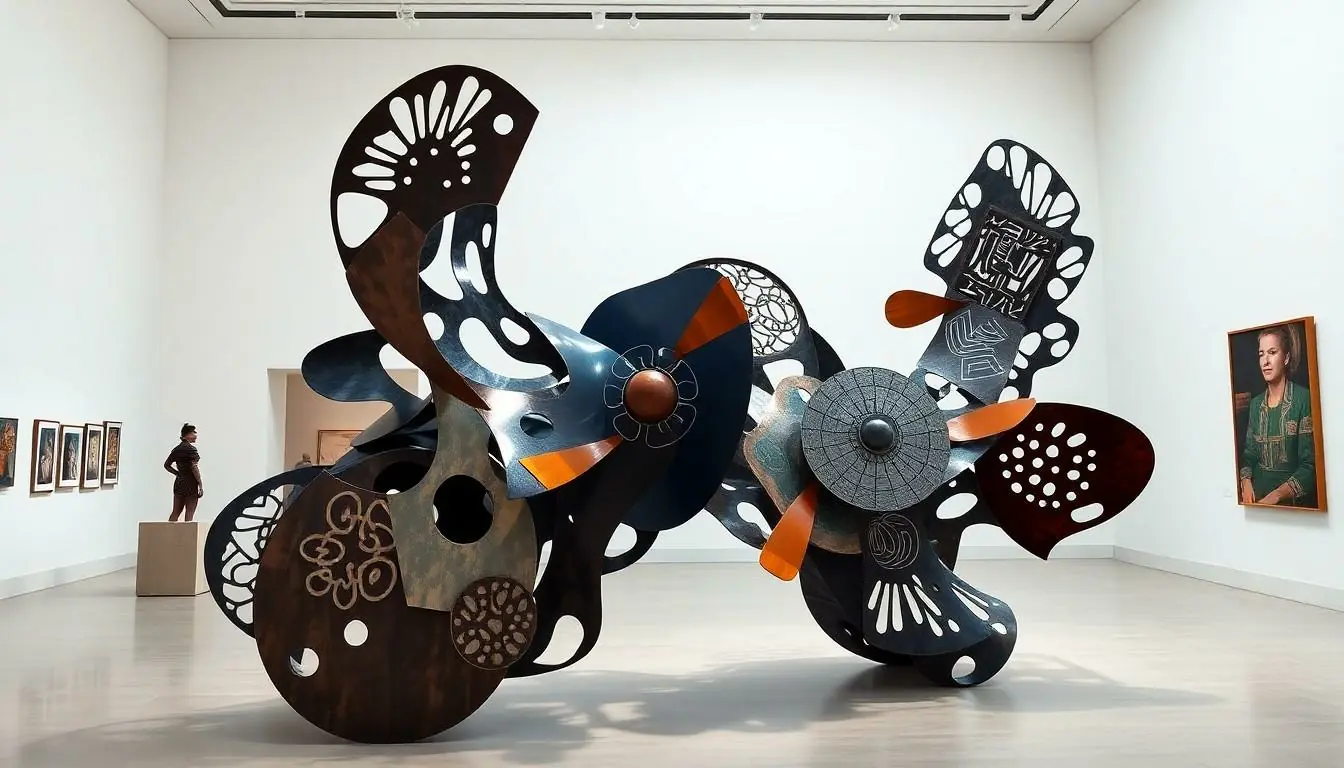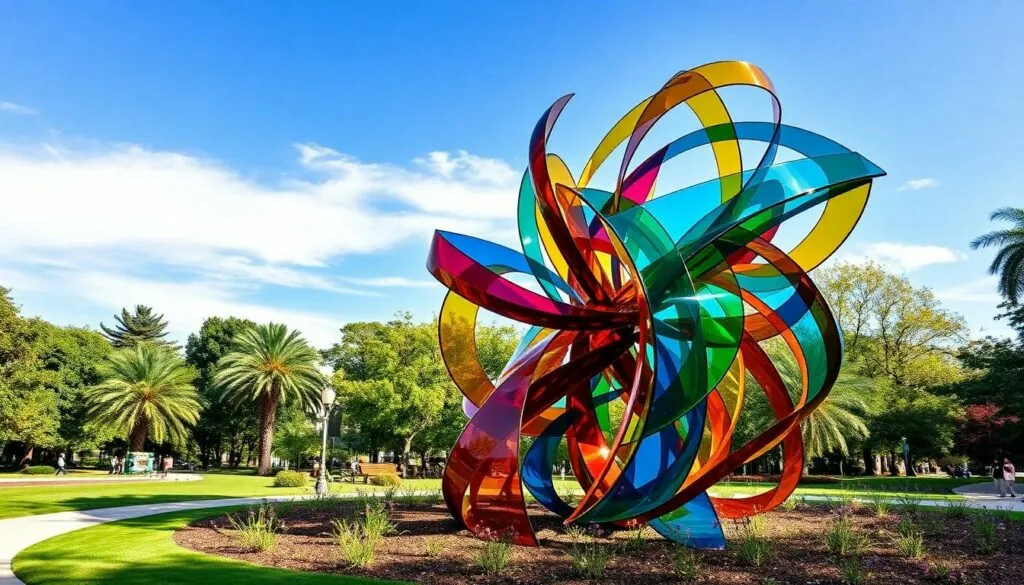Table of Contents
ToggleWhen it comes to art, abstract sculptures are like the rebellious teenagers of the art world. They’re bold, unpredictable, and often leave you scratching your head while wondering what on earth you just saw. These three-dimensional wonders break away from traditional forms, inviting viewers to dive into a realm where shapes and materials dance in a delightful chaos.
What Is An Abstract Sculpture
Abstract sculpture represents a departure from traditional art forms. It emphasizes non-representational and non-objective designs, allowing for personal interpretation. Artists create abstract sculptures using diverse materials, including metal, stone, wood, and glass. Each medium impacts the final appearance and texture, influencing viewer perception.
Shapes in abstract sculptures don’t necessarily mimic reality. Instead, they often evoke emotions or provoke thoughts through their bold forms. The interplay of line, volume, and space becomes essential. Viewers engage with abstract sculptures on a sensory level, making their interpretations subjective.
These sculptures can vary greatly in size. Some sculptures reach monumental heights while others reside on tabletops. Locations for display often range from galleries to public parks, broadening audience access. Many contemporary artists challenge norms, pushing the boundaries of what constitutes sculpture itself.
The movement began in the 20th century, correlating with various art movements like Cubism and Futurism. Iconic artists like Henry Moore and Alberto Giacometti carved their own paths in this domain. Their works contributed to a significant dialogue about form and expression.
Abstract sculpture invites exploration and encourages a personal connection. It challenges viewers to alter their understanding of art and beauty. Recognizing its significance helps appreciate the broader context of modern art.
Characteristics Of Abstract Sculpture

Abstract sculptures possess unique traits that differentiate them from traditional art forms. These three-dimensional works emphasize creative freedom and encourage individual interpretation.
Use Of Form And Shape
Form and shape play crucial roles in defining abstract sculpture. Sculptures may feature geometric patterns or organic curves, often conveying emotions through their physical presence. Artists manipulate space within their designs, creating tension and movement that captivate observers. The interplay of positive and negative space can invite exploration and contemplation, allowing viewers to experience art in a more dynamic manner. Emphasizing abstraction encourages a departure from literal representation and inspires deeper connections with the artwork.
Color And Material Choices
Color and material choices enhance the visual impact of abstract sculptures. Artists combine metals, wood, stone, and glass to create diverse textures and finishes that add dimension. The reflective quality of glass can evoke lightness, while the solidity of stone imparts permanence. Various color palettes convey different moods, shaping viewer emotions and responses. Bright hues might energize and engage, while muted tones provide calmness. These choices shape the overall aesthetic and thematic experience of the sculpture, enhancing its significance within the broader context of art.
Types Of Abstract Sculpture
Abstract sculpture includes various styles, each offering unique perspectives and interpretations. Two primary categories, geometric and organic abstract sculptures, dominate this field.
Geometric Abstract Sculpture
Geometric abstract sculptures utilize shapes and forms based on mathematical principles. Artists often focus on symmetry, balance, and repetition, resulting in visually striking pieces. Artists like Ellsworth Kelly and Donald Judd exemplify this style through their precise arrangements of lines and planes. These sculptures evoke a sense of order and clarity, engaging viewers with their structured aesthetics. Often constructed from materials such as metal and concrete, geometric sculptures create a powerful visual impact, drawing attention to their form and spatial relationships.
Organic Abstract Sculpture
Organic abstract sculptures embrace fluid, natural shapes that resemble forms found in nature. This style prioritizes curves and irregularities, reflecting the complexities of organic life. Influential artists like Henry Moore emphasize soft, flowing lines, inviting emotions and connections to human experiences. Sculptures through this lens often utilize materials like wood, stone, or clay, enhancing their tactile qualities. Their dynamic forms provoke thought, encouraging individual interpretations rooted in personal experiences and feelings. The unpredictable nature of these sculptures captivates viewers, offering an immersive encounter with art.
Techniques Used In Creating Abstract Sculptures
Abstract sculptures employ various techniques that enhance creativity and expression. Each method contributes to the unique identity of the artwork.
Carving And Modeling
Carving and modeling serve as foundational techniques in abstract sculpture creation. Artists often choose materials like stone, wood, and clay for their ability to convey texture and form. Tools such as chisels and knives enable precise cuts, allowing artists to shape their vision gradually. Some sculptors prefer modeling, using clay or wax to build forms organically. This tactile method encourages spontaneous creativity, reflecting the artist’s emotions during the process. Ultimately, both carving and modeling foster intimate connections between the artist and the sculpture.
Assembling And Casting
Assembling and casting techniques also play significant roles in abstract sculpture development. Assemblage involves combining various materials like metal, glass, and found objects, creating dynamic compositions. These choices can result in distinct textures and visual interest. Trusting their instincts, artists often experiment with the arrangement of components, which enhances the sculpture’s emotional impact. Casting, on the other hand, allows for replication of original forms using materials like resin or bronze. This method preserves the integrity of the design while showcasing intricate details. Both techniques invite viewers to contemplate the relationships between different elements in the artwork.
Notable Abstract Sculptors
Abstract sculpture showcases the ingenuity of various artists who reshape perceptions of art. Renowned sculptors have made significant contributions to this dynamic field, creating works that challenge conventions and engage viewers.
Famous Works And Their Impact
Henry Moore’s “Reclining Figure” revolutionized public sculpture, emphasizing the interplay between organic forms and the surrounding landscape. Its expansive presence in parks invites contemplation and connection with nature. Alberto Giacometti’s “Walking Man” captures a haunting sense of isolation and existential struggle, resonating deeply with the viewer’s emotions. This work reflects the post-war anxiety that characterized its era. Additionally, Isamu Noguchi’s “The Play Mountain” engages audiences with its playful, interactive capabilities, blurring the lines between art and environment. His ability to integrate sculpture into the landscape enhances accessibility and promotes a more personal interaction with art. Each of these sculptors has pushed boundaries, solidifying abstract sculpture’s prominence in contemporary art conversations.
Abstract sculpture stands as a testament to creativity and innovation in the art world. By breaking away from traditional forms it encourages a personal connection between the viewer and the artwork. The diverse materials and techniques used by artists allow for a rich exploration of emotions and interpretations.
Whether through geometric precision or organic fluidity these sculptures invite engagement and provoke thought. As abstract sculpture continues to evolve it challenges perceptions of beauty and meaning in art, ensuring its relevance in contemporary discussions. The journey through abstract forms not only enriches the viewer’s experience but also highlights the limitless possibilities within the realm of artistic expression.







